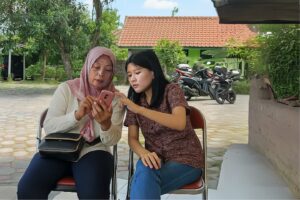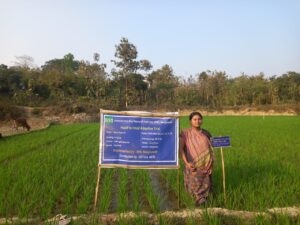
It’s easy to think of rice as a commodity that sells itself.
Demand is growing faster than production, so any novice merchant with a warehouse full of paddy and a telephone can sell it. Just offer a slightly lower price than the others and hope your supplier holds up his end of the deal. Oh, and never mind the quality. Just mix enough of variety C with premium variety A to suit the price you’re getting and hope that nobody notices.
Welcome to the “red ocean” of rice trading. It’s a term used for a saturated market in which competition is both fierce and ruthless; where just about everything is compromised in the battle to survive. Hence the connotation of blood in the water. As unattractive as the picture may be, it is nevertheless an accurate portrayal of rice trading in many Asian countries.
There is another way. It regards rice and rice consumers in a more reverential fashion, and perhaps, because of the growing affluence of rice consumers, it may be the way of the future.
Wanglee Company Ltd. was formed in Bangkok in 1871, but its principals had traded rice even before that, buying from bloated rice barges plying the country’s river system. It grew to own five rice mills on the banks of the Chao Phraya River before the ocean began to turn red, and the risks became too great. The company diversified into real estate, banking, and insurance and all but forgot about rice trading until 1988, when it formed a new company called Chaitip, to resurrect its rice business.
Then, just 3 years ago, a fifth generation son of the Wanglee family joined Chaitip after gaining a master’s degree in business administration from Vanderbilt University in Nashville, Tennessee. Viput Wanglee, 35, had earlier begun his university education with a bachelor’s degree in architecture, and the rationale behind the switch says a lot about his approach to his job.
“Architecture is a way of thinking,” he says. “It teaches us to think from different angles. Importantly, architecture is a commercial art. What an architect designs has to respond to the issues it is attempting to resolve. It must work; it must sell. It is business mixed with art.”
He served a working apprenticeship by marketing consumer goods for firms like Unilever and Johnson & Johnson before joining his father, Vuttichai Wanglee, at the helm of Chaitip.
 His father is managing director, Mr. Viput is assistant to the managing director for sales and marketing, and his brothers Vuttiphol and Thinnaphan are assistants to the managing directors for production and accountin and finance, respectively.
His father is managing director, Mr. Viput is assistant to the managing director for sales and marketing, and his brothers Vuttiphol and Thinnaphan are assistants to the managing directors for production and accountin and finance, respectively.
Surprisingly, the company that is stretching the boundaries of modern marketing still occupies the same buildings in Bangkok’s Thonburi District that have been the seat of the family’s fortunes for more than 150 years.
When Mr. Viput joined the company, Chaitip was enjoying success as an exporter to Hong Kong. Its Qing Ling Zhibrand of premium grade Thai jasmine rice had an 8% share of the Hong Kong market, amounting to a value of US$9 million per year. Importantly, it was selling at $800 per ton when others were selling the same product for $700, simply because it gave an assurance of consistent quality and worked hard to deliver what it promised.
“The quality of our Qing Lingbrand rice never changes, Zhi and consistent quality in rice is very difficult to achieve because agricultural products are very inconsistent,” says Mr. Viput, adding that Chaitip prides itself on its honesty, accountability, and focus on customers’ interests. It also gives its word that, even in times of rising raw material costs, it will still deliver at agreed rates.
However, it never attempts to deliver at low prices. “We are not cheap. We charge premium prices,” Mr. Viput says.
“When I joined the company, we decided to diversify into the domestic market because exporting was very risky, particularly with volatile currency exchange rates. In consumer products, the large margins mean you can afford to make a few mistakes. But with rice, you can’t make any mistakes at all. It’s hugely risky. So we decided to concentrate our efforts on the local food service sector.”
The prospect of diving into Thailand’s red ocean rice market was not attractive, so Mr. Viput, a follower of modern marketing practices, set out, in a centuries-old industry, to create a new market; to find a niche in which Chaitip could enjoy its own “blue ocean”—a market with little or no competition.
“Everyone eats differently, everyone has a different taste in music, every person enjoys different things on TV. That’s why we have cable TV,” Mr. Viput explains. “We had to define the needs of our target consumers; to find out what they needed above everything else. We had to find a niche market that matched what we had to offer. And what we had to offer was the finest quality Thai rice, reliability, consistency, and honesty.”
He hired a research firm to survey leaders in the food service industry and found that the biggest need of hotels, restaurants, and chefs was an assurance that the quality of their cooked rice would not change.
“They were saying: ‘I don’t want any headaches, I don’t want complaints from my customers, or they won’t come back again.’ And no one in the market was responding to those needs.”
Mr. Viput’s niche market began to take shape. But he realized that the concerns of his target customers were focused purely on the dining table. He was left wondering how he might maintain the quality of his company’s rice from the delivery truck to the dining table, given its hazardous passage through storage and cooking along the way.










